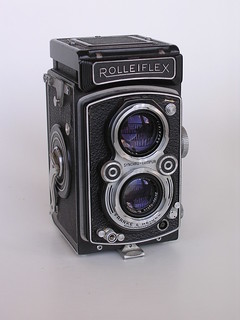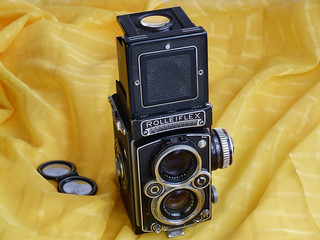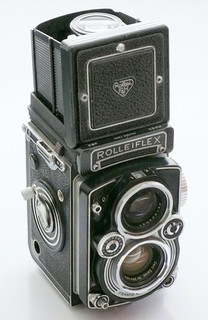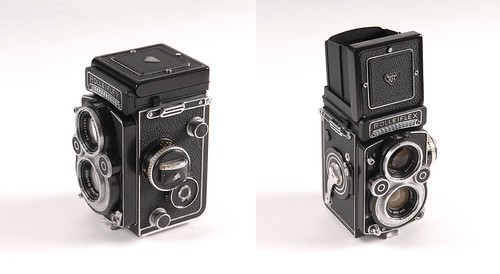Rolleiflex 3.5 series
Soon after the end of WWII Franke & Heidecke started further improvements of their hugely succesfull 6x6 Automat series. This resulted in a series of Rolleiflex 3.5 TLR's which were produced during a period of 27 years.
Contents
Rolleiflex 3.5 (type K4)

|
| Rolleiflex 3.5 build K4 image by Alessio Corsi (Image rights) |
Also often called Rolleiflex Automat model X.
- Production : from 1949 to 1951, about 35.660 units
- Format : 12 exposures of 6 x 6 cm on 120 type rollfilm.
Furthermore a Plate adapter for sheet film and a Rolleikin adapter for 35mm film cartridges can be used. - Taking lens:
Carl Zeiss Tessar 1:3.5 f=75mm, Coated.
or : Zeiss Oberkochen Opton Tessar 1:3.5 f=75mm, Coated.
or : Schneider-Kreuznach Xenar 1:3.5 f=75mm, Coated. - Viewing lens: 1:2.8 f=75mm, coated
- Filter Bayonet : Both lenses, size 1.
- Parallax error correction.
- Shutter: Compur-Rapid X CR00 leafshutter. Speeds 1 to 1/500 sec. and B.
- Flash synchronization : Sync socket on frontpanel. X synchronization
- Selftimer
- Double exposure prevention
- Color Lacquer : Black
- Color Leatherette : Black
- Dimensions WxDxH: 94 x 95 x 143 mm
- Weight: 980 grams
Rolleiflex 3.5 A (type K4A)

|
| Rolleiflex 3.5 A (type K4A) image by Rick Oleson (Image rights) |
Also often called Rolleiflex Automat model 4.
Only differences with Rolleiflex 3.5 shown.
- Production : from 1951 to 1954, about 109.000 units
- Viewing lens: Heidosmat 1:2.8 f=75mm, coated
- Shutter: Synchro-Compur MX CR00 leafshutter. Speeds 1 to 1/500 sec. and B.
- Flash synchronization : Sync socket on frontpanel. M and X synchronization
- On later models use of Rolleifix (tripod attachment) possible
- Weight: 970 grams
Rolleiflex 3.5 B (type K4B)

|
| Rolleiflex 3.5B image by cameramaniacs.com (Image rights) |
Only differences with Rolleiflex 3.5 A shown.
- Production : from 1954 to 1956, about 94.000 units
- Exposure adjustments now with an Exposure Value Scale (EVS)
- Switch to overrule the Double Exposure Prevention
- Memo disc on Focus knob
- Use of Rolleifix (tripod attachment) possible
- Dimensions WxDxH: 99 x 96 x 146 mm
- Weight: 980 grams
Rolleiflex 3.5 C (type K4C and K41)

|
| Rolleiflex 3.5C image by Iza Lemargouillat (Image rights) |
Only differences with Rolleiflex 3.5 B shown.
- Production : from 1956 to 1959, about 43.000 units
- Taking lens:
Type K4C : Carl Zeiss Oberkochen Planar 1:3.5 f=75mm, Coated.
or Type K41 : Schneider-Kreuznach Xenotar 1:3.5 f=75mm, Coated. - Filter Bayonet : Both lenses, size 2
- Lighmeter system : K4C standard and K41 optional, uncoupled, Selenium photo element, 2 ranges, meter in place of the Memo disc
- Coupled Depth Of Field indicator
- Dimensions WxDxH: 111 x 96 x 146 mm
- Weight: 1120 grams
Rolleiflex 3.5 E2 Model 1 (type K4C2)
Only differences with Rolleiflex 3.5 C shown.
Note that the Rolleiflex "3.5 E2" came later on the market than the "3.5 F" and was the result of a demand for a Rolleiflex 3.5 without build-in lightmeter.
In construction it is largely based on the 3.5C
- Production : from 1959 to 1960, about 2000 units
- Taking lens:
Carl Zeiss Oberkochen Planar 1:3.5 f=75mm, Coated.
or : Schneider-Kreuznach Xenotar 1:3.5 f=75mm, Coated. - Removable finder hood
- Lighmeter system : None, but prepared for an after-sales modification with an uncoupled one, Selenium photo element, 2 ranges, meter in place of the Memo disc
- Dimensions WxDxH: 112 x 98 x 148 mm
Rolleiflex 3.5 E2 Model 2 (type K4C3)
Only differences with Rolleiflex 3.5 E2 Model 1 shown.
Note that the Rolleiflex "3.5 E2" came later on the market than the "3.5 F" and was the result of a demand for a Rolleiflex 3.5 without build-in lightmeter.
In construction it is largely based on the 3.5C
- Production : from 1961 to 1962, about 2000 units
- Prepared for an after-sales modification with a Flat Glass (to improve film flatness) in the film gate
Rolleiflex 3.5 E3 (type K4G)

|
| Rolleiflex 3.5 E3 (type K4G) image by Matt Phillips (Image rights) |
Only differences with Rolleiflex 3.5 E2 Model 2 shown.
Note that the Rolleiflex "3.5 E3" was produced parallel to the "3.5 F" and was the result of a demand for a Rolleiflex 3.5 F without build-in lightmeter.
In construction it is largely based on the 3.5F.
- Production : from 1961 to 1965, about 5035 units
- Taking lens:
Carl Zeiss Oberkochen Planar 1:3.5 f=75mm, Coated, 6 elements.
or : Schneider-Kreuznach Xenotar 1:3.5 f=75mm, Coated, 6 elements. - Combined lever (MXV) for Selftimer and M- and X-synchronization.
Rolleiflex 3.5 F
Rolleiflex 3.5 F Model 1 (type K4D)
Only differences with Rolleiflex 3.5 C shown.
- Production : from 1958 to 1960, about 20.000 units
- Shutter: Differential Synchro-Compur MXV CR00 leafshutter. Speeds 1 to 1/500 sec. and B.
- Lighmeter system : Coupled, Selenium photo element
- Removable finder hood
- Combined lever (MXV) for Selftimer and M- and X-synchronization.
- Dimensions WxDxH: 112 x 98 x 148 mm
- Weight: 1220 grams
Rolleiflex 3.5 F Model 2 (type K4E)
Only differences with Rolleiflex 3.5 F Model 1 shown.
- Production : from 1960 to 1960, about 11.500 units
- No button for LV (Light Value) lock.
- Prepared for an after-sales modification with a Flat Glass (to improve film flatness) in the film gate (optional)
Rolleiflex 3.5 F Model 3 (type K4F)

|
| Rolleiflex F, model 3 (type K4F), White Face image by Richard Frances (Image rights) |
Only differences with Rolleiflex 3.5 F Model 2 shown.
- Production : from 1960 to 1976, about 121.000 units
- Taking lens:
Carl Zeiss Oberkochen Planar 1:3.5 f=75mm, Coated, 6 elements.
or : Schneider-Kreuznach Xenotar 1:3.5 f=75mm, Coated, 6 elements. - Shutter: Synchro-Compur MXV CR00 leafshutter. Speeds 1 to 1/500 sec. and B.
- Rollei differential gear for coupling with the lightmeter
Changes during the production period :
- From Nov.1965 : Now also 220 film possible, giving 24 exposures 6x6cm
- From Nov.1965 : No preparation for Flat Glass anymore
- From halfway 1971 : Smooth pressure plate
- From halfway 1971 : Plain Frontplate, with text "Rollei-Werke, Franke & Heidecke", the so called White Face
Bibliography
- Claus Prochnow, Rollei Report 2, third edition, Braunschweig, Lindemanns Verlag, 2008, ISBN 3-89506-220-0.